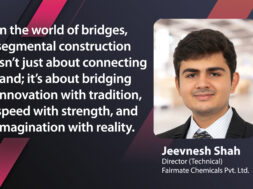Advancing bridge construction with cutting-edge technology

In the world of bridges, segmental construction isn’t just about connecting land; it’s about bridging innovation with tradition, speed with strength, and imagination with reality.
In the ever-evolving realm of construction, innovation plays a pivotal role in enhancing infrastructure development. FAIRMATE, a leading player in the construction chemicals industry, is at the forefront of this transformation. With a commitment to delivering cost-effective solutions and world-class services, FAIRMATE has emerged as a beacon of excellence in the Specialty Construction Chemical Industry. In collaboration with M/s Resin Building Products Ltd., UK, FAIRMATE has introduced over 500 ground breaking products in Civil Engineering, revolutionising how we build bridges and other critical structures.
A bridge, by definition, is a structure designed to conquer obstacles like water bodies, valleys, or roads, facilitating seamless passage. Building bridges is a complex endeavour that depends on several critical factors, including the bridge’s purpose, length, span, terrain, and the materials employed in its construction.
In bridge construction, the choice of construction method can significantly impact the project’s efficiency and durability. FAIRMATE offers state-of-the-art solutions for segmental bridge construction, a method gaining prominence for its advantages. Segmental bridges, characterised by their modular and prefabricated segments, are becoming the hallmark of modern infrastructure projects in India.
Cast-in-Situ Method: This method is well-suited for short bridges but is inherently time-consuming. It encompasses the following steps:
· Erection on ground-supported staging.
· Casting of concrete on-site.
· Dismantling of staging after concrete curing.
Precast Segmental Method: Ideal for long bridges with multiple spans, this method offers precision and efficiency. It involves the following steps:
· Casting of precast segments in a controlled casting yard.
· Transportation of precast segments to the construction site.
· Erection of precast segments using specialised equipment such as launchers or cranes.
· External prestressing for added strength.
· Grouting to enhance structural integrity.
The Advantages of Segmental Bridge Construction
Segmental bridge construction brings a plethora of advantages to the table, making it the preferred choice for many infrastructure projects:
· Cost-Effectiveness: Extremely economical for long spans, segmental construction maximises budget efficiency.
· Quality Control: Prefabricated segments undergo meticulous quality checks, reducing the risk of defects.
· Rapid Deployment: The structure can be immediately loaded after prestressing, minimising disruptions.
· Maintenance Flexibility: Prestressed cables can be inspected and replaced anytime, ensuring long-term reliability.
· Lightweight Design: Thin bridge sections result in lower weight, reducing the overall load on supporting structures.
· Minimal Maintenance Costs: Robust construction and high-quality materials translate to lower maintenance expenses.
· Speedy Construction: Compared to traditional methods, segmental construction is faster, reducing project timelines and minimising disruptions.
Constructing segmental bridges involves a precise sequence of steps:
Casting of Segments: Segments are cast using either the Short Line Method (for slower production) or the Long Line Method (for faster production). After casting, segments are cured and stored.
Transfer to Erection Site: Once cured, segments are transported to the erection site using specialised equipment.
Erection of Segments: Various methods, such as Balanced Cantilever, Progressive Placement, Span by Span, and Incremental Launching erection, are employed to assemble the precast segments on-site.
Epoxy Gluing: Epoxy glue is applied between segments to prevent grout leakage during grouting.
External Prestressing: The bridge’s final strength is achieved through pre-tension or post-tension methods.
Grouting: Grouting protects strands against corrosion and enhances the bond between prestressing steel and surrounding concrete.
For more info visit : www.fairmate.com
Cookie Consent
We use cookies to personalize your experience. By continuing to visit this website you agree to our Terms & Conditions, Privacy Policy and Cookie Policy.










